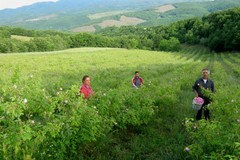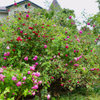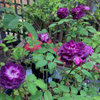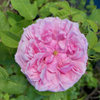Chill hours for Damask 'Madame Hardy'
perfectusinfinitusvita
8 years ago
Featured Answer
Sort by:Oldest
Comments (60)
Related Discussions
What a scent!
Comments (39)Yes Jeri! :-) Burling added it to my spring list. :-) I like to learn from other people's mistakes, save me time and money. Lol. Just like buying a scooter/mortorcycle, I'd check out the reviews and other riders complains before buying a bike. Except I totally felt in love with one Italian bike-Piaggio MP3, I somehow ended up with 3 of them, different colors and different sizes of engines.......made a mistake right there, one of them is too big for me to handle, still parked in my garage, still love to look at it. it's a beautiful machine......I should read more reviews from lady riders, it's too heavy for girls....See MoreDamasks and Portlands in SoCal?
Comments (9)Hi Sylvia Wendel! We get just about the same winter night temperatures around here, so I think it would be cold enough for a Damask or Portland to bloom. Fortunately I don’t have major issues with rust or blackspot in this area. I don’t spray my roses at all and their leaves look fine up until late summer/early fall. Rust and blackspot tends to show up towards the end of the growing season in autumn (hasn’t affected my damasks yet, but I’ve only had them for a few years, [they are on their own roots]) but the roses still look fine, it’s not severe and doesn’t bother me too much. I think it all depends on location. I looked up Portland of Glendora and it is a BEAUTIFUL rose! I also heard that it blooms often throughout the growing season and has a heavenly scent. Seems like a winning combination to me! It is so cool that it is named after your city too! Here are a few links that might help you out a bit, the first one is to another Houzz conversation about this rose and includes many beautiful pictures, and the second one is for the HelpMeFind page for this rose: The Portland From Glendora - Spring 2019 "Portland from Glendora" rose Description I’ve also found that there are only two places that sell Portland of Glendora in the U.S.; one is in Florida, and one is a 3-4 hour drive from Glendora in Visalia, called Burlington Rose Nursery. Here is a link from HelpMeFind that shows the places where it is sold: "Portland from Glendora" rose Nurseries Good luck and have a lovely weekend, damask_rose_5 : )...See MoreOriginal Damask Rose from Middle East
Comments (73)@LindaLu LindaLu--If you are in Southern California, I would recommend finding out how well Ispahan would do in your climate before you make a decision. My understanding is that it, like all European once-bloomers, needs a certain amount of cold weather in winter to form buds when spring comes. I don't know how your climate would affect a repeat-bloomer like AD or its once-blooming relative Kazanlik. What I can tell you is that Ispahan, Autumn Damask, and Kazanlik are all about the same shade of pink, which I would describe as medium. The portland hybrid Marchesa Boccella is just about the same color if you are familiar with it. In growth habit, Ispahan is tall. Mine is probably close to seven feet--some of the canes are upright, several which were arching over with the weight of their blooms this spring are now producing new upright laterals. When people see my roses, Ispahan always draws attention. in my climate it has a long bloom cycle and is spectacular in bloom. When not in bloom, it is a clean, neat, healthy rose. I would not want to be without it. In fact, I have two and when the smaller plant was killed by a vole, I propagated another to take its place. Autumn Damask, for me, is a smaller plant, and though beautiful in a different way, does not draw the attention of strangers as Ispahan does . I am fascinated by it partly because of its history and its link to the rose trade--I love that connection even though it isn't part of my cultural heritage. I had read about this rose before I ever saw it, and when I did see it at a nearby botanical garden it took me by surprise, announcing its presence in a small courtyard as I entered by the heavenly scent of its flowers. There were six plants in full bloom, flanked by Rosa Mundi and Apothecary, and when I saw the ID, I knew I was looking mentioned by Vergil. It was exotically beautiful--canes and foliage as well as flowers--and did not resemble like any rose I had ever seen; it has been my special favorite ever since. Do, please, let us know which rose you select. I never tire of hearing about Damasks, and am glad to know others who love them, too. Lindsey...See MoreIceberg and Madame Hardy
Comments (21)For my money, it would be Madame Hardy all the way. Here in Southern California Iceberg is a landscaping rose, as in growing at drive throughs and in front of tire stores ... it’s also all over the community where I live. In this climate it seems to seldom get big and full — mostly singles, fall quickly, meh overall. But Mme. H. — now that is scrumptious. iMHO....See MoreMelissa Northern Italy zone 8
8 years agolast modified: 8 years agoperfectusinfinitusvita thanked Melissa Northern Italy zone 8malcolm_manners
8 years agolast modified: 8 years agonikthegreek
8 years agolast modified: 8 years agomad_gallica (z5 Eastern NY)
8 years agosummersrhythm_z6a
8 years agolast modified: 8 years agonikthegreek
8 years agosummersrhythm_z6a
8 years agoUser
8 years agoMelissa Northern Italy zone 8
8 years agosummersrhythm_z6a
8 years agoBuford_NE_GA_7A
8 years agotuderte
8 years agomalcolm_manners
8 years agoUser
8 years agoperfectusinfinitusvita
8 years agosultry_jasmine_nights (Florida-9a-ish)
8 years agolast modified: 8 years agosummersrhythm_z6a
8 years agolast modified: 8 years agotuderte
8 years agoUser
8 years agoperfectusinfinitusvita
8 years agoAlana8aSC
8 years agosummersrhythm_z6a
8 years agoTessiess, SoCal Inland, 9b, 1272' elev
8 years agoperfectusinfinitusvita
8 years agoBuford_NE_GA_7A
8 years agomad_gallica (z5 Eastern NY)
8 years agoperfectusinfinitusvita
8 years agoUser
8 years agolast modified: 8 years agomalcolm_manners
8 years agoSheila z8a Rogue Valley OR
8 years agosubk3
8 years agosummersrhythm_z6a
8 years agolast modified: 8 years agomalcolm_manners
8 years agosummersrhythm_z6a
8 years agonikthegreek
8 years agolast modified: 8 years agoUser
8 years agoAquaEyes 7a NJ
8 years agoTessiess, SoCal Inland, 9b, 1272' elev
8 years agoUser
8 years agoUser
8 years agolast modified: 8 years agoTessiess, SoCal Inland, 9b, 1272' elev
8 years agonikthegreek
8 years agoAquaEyes 7a NJ
8 years agolast modified: 8 years agonikthegreek
8 years agolast modified: 8 years agoUser
8 years ago
Related Stories

GARDENING GUIDESWhat Kind of Roses Should You Grow?
Want to add the beauty of roses to your garden? Find out which ones, from old-fashioned to modern, are right for you
Full Story







AquaEyes 7a NJ